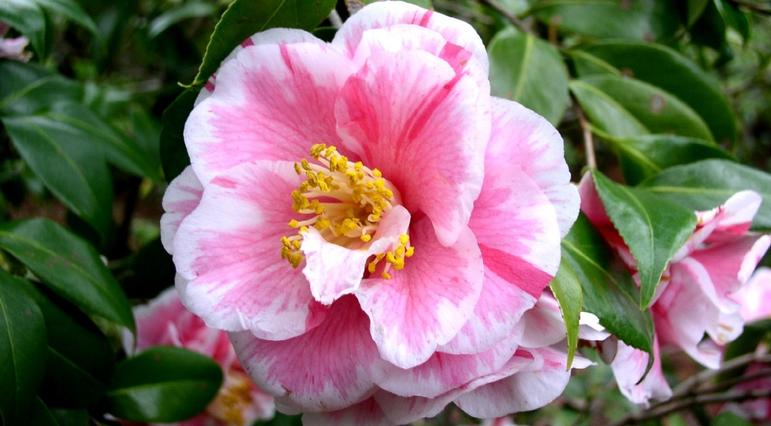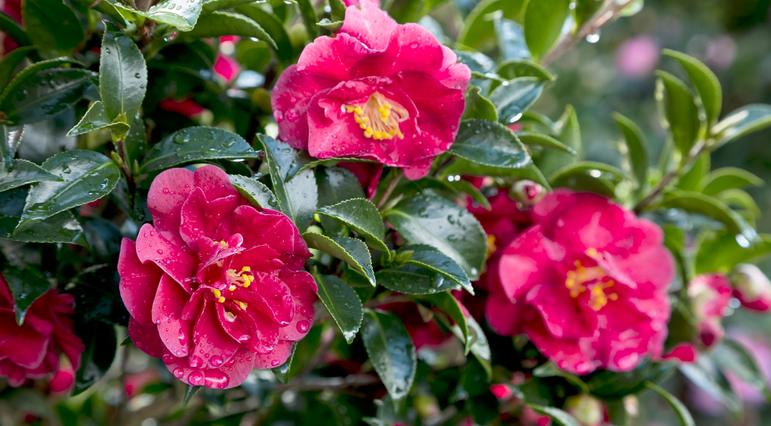Adding Camellias to Your Landscape

Camellia japonica 'Herme'
What’s not to like about Camellias?
They:
- Are green all year
- Flower for a long time when flowers are hard to find in the landscape
- Have a wide range of blossom types and colors
- Have low-maintenance needs for water, fertilizer, and pesticides
- Are long-lived
- And according to many, are reasonably deer resistant
With all these positive attributes, they are a great addition to USDA Zone 7-10 gardens. There are even a few camellias capable of surviving in USDA Zone 6 and colder.
The genus Camellia contains roughly 300 species but only a handful are grown for landscapes and just two, C. japonica and C. sasanqua, are regularly offered. But because of their popularity, there are thousands of named types of these 2 species. Cultivars range from 1’ to 20’ at maturity and plant forms also vary greatly from prostrate to pendulous, conical and columnar. Some can be staked, trellised or pruned into a patio tree. Although we tend to pay more attention to cold tolerance, some camellias handle the heat of Zone 10 better than others.
Here are the general characteristics and needs of the two species:
Camellia sasanqua
- Bloom between Oct and Jan (South)
- Bloom between Oct and Dec (North)
- Best in part shade to cool day sun
- Older plants tolerate more sun
- Loose, well-draining acid soil (pH 5 - 6.5)
- Survives mainly on rainfall after the first year
- Irrigate only during dry spells
- Not salt tolerant
- Elliptical shiny evergreen leaves
Camellia japonica
- Bloom between Jan and Mar (South)
- Bloom between late Feb and May (North)
- Best in part shade
- Older plants tolerate more sun
- Loose, well-draining acid soil (pH 5 - 6.5)
- Survives mainly on rainfall after the first year
- Irrigate only during dry spells
- Not salt tolerant
- Same but the leaves and flowers are larger
Uses
Camellias are impressive even when not in flower. Use them in beds with other acid-preferring plants like hollies, blueberries, azaleas and mahonias, and not within turf areas. Disguise a fence line mixed with other shrubs in a colorful and textural tapestry, or use alone as a hedge or screen. Include several camellia varieties for an especially long bloom display. Espalier them against a wall or choose one of the many natural forms to accent your space. Planted in mass they are spectacular or containerized they make dramatic specimens. Container plants are less cold hardy but they can also be moved to a protected area in winter.
Choosing your Site
You may see older camellias in a sunny exposure but their site was probably shadier in the past. Older plants can tolerate more sun as their canopies shade their own roots. Generally, camellias should be planted where they are protected from the early morning sun and direct hot summer afternoon sun. Also choose a site away from trees with aggressive roots, that has good air movement but is protected from cold winds. Drainage is important. Heavy clay soils or overly-sandy soils can both be improved by amending with 3-6” of organic matter into the top 12” of the planting area.
Planting
In their southern range, the best time to plant camellias is in the fall so roots can develop sufficiently before the heat of summer. Further north (Zones 6 and 7), planting in spring allows the shrub to become established enough to survive the winter cold. Be sure the root ball is saturated before planting; you can soak it for a few hours in a bucket. Dig the planting hole 2-3 times wider than the root ball and slightly shallower. Finish by planting the root ball 1-2 inches above the soil line so over time the plant doesn’t sink below the soil surface. Spread 2-3” of mulch over the root zone but not up against the trunk. Space plantings to allow for mature size. Water regularly during the first year, about 1” per week. Even though fairly drought tolerant after the first year, camellias will benefit from 1” of water about every 10-14 days and 1” weekly while blooming.
Fertilizing
Fertilizer can be applied about 1-3 times per year (March, May and July) depending on the needs of your plant dictated by its age and environmental conditions. First, rake the mulch back to expose the soil. Water your camellia both before and after fertilizing. Start with a spring application about mid-March or after flowers have dropped. This supports the development of new growth buds. If your camellia is well established and growth isn’t your main goal, choose a fertilizer with a nutrient ratio that is low in nitrogen and greater in phosphorus and potassium, such as N4-P8-K8. Younger plants or those showing signs of poor growth, pale foliage or undesirable branching may need more nitrogen such as in a 12-4-8 composition. A deficiency in phosphorus may show as stunted growth or poor root development. Plants deficient in potassium usually grow more slowly, have fewer flowers and are more susceptible to disease. Always be sure your fertilizer also contains the minor elements magnesium, sulfur, calcium, iron, manganese, copper, zinc, boron and molybdenum, and follow the product label directions. Acid-forming Azalea and Camellia fertilizers should be avoided on young and containerized plants. A soil test will help you determine if the pH is in range so the camellia can take advantage of the available nutrients.
Pruning
Thanks to their slow growth and natural good shape, camellias need little pruning. If desired, prune in spring just prior to the flush of new growth or at least before summer when flower buds form. Remove dead or weak wood anytime. Shorten lower branches to coax upright growth or shorten top growth to encourage bushiness. When pruning, cut just above a scar that indicates the end of the previous year’s growth, where the bark texture changes.
Problems
Pests are few. Aphids are most prevalent during periods of new growth and are usually gone by the hottest part of summer. Tea scale and wax scale may be evident. Spider mites may appear during hot, dry conditions. Possible diseases include leaf spot, dieback, leaf gall, petal blight and root rot, but rarely pose serious problems with camellias that are correctly planted and cared for. Bud drop can occur when the plant self-prunes, but it can also be caused by over-watering, drought or sudden freezes. Scorched or yellow areas in the center of leaves usually indicate sunburn. It is common in spring for leaves which are several inches back from the branch tips to yellow as the plant moves food resources to new growth. The weakened yellow leaves may get fungal spots, but disease rarely moves into the rest of the plant. If tip leaves are green, this is a normal response and the plant should look fine in a few weeks without fungicides or any additional fertilizer.
Again, what’s not to like about Camellias?
So… green all year, flowers for a long time in a wide variety of forms and colors, long-lived and deer resistant - Camellias shine even when they’re not in flower. They have a place even in the not-so-Southern garden.

Camellia sasanqua October Magic? 'Ruby™'
My Newest Video
caption, eh.
-
128 Raleigh St, NC 27540